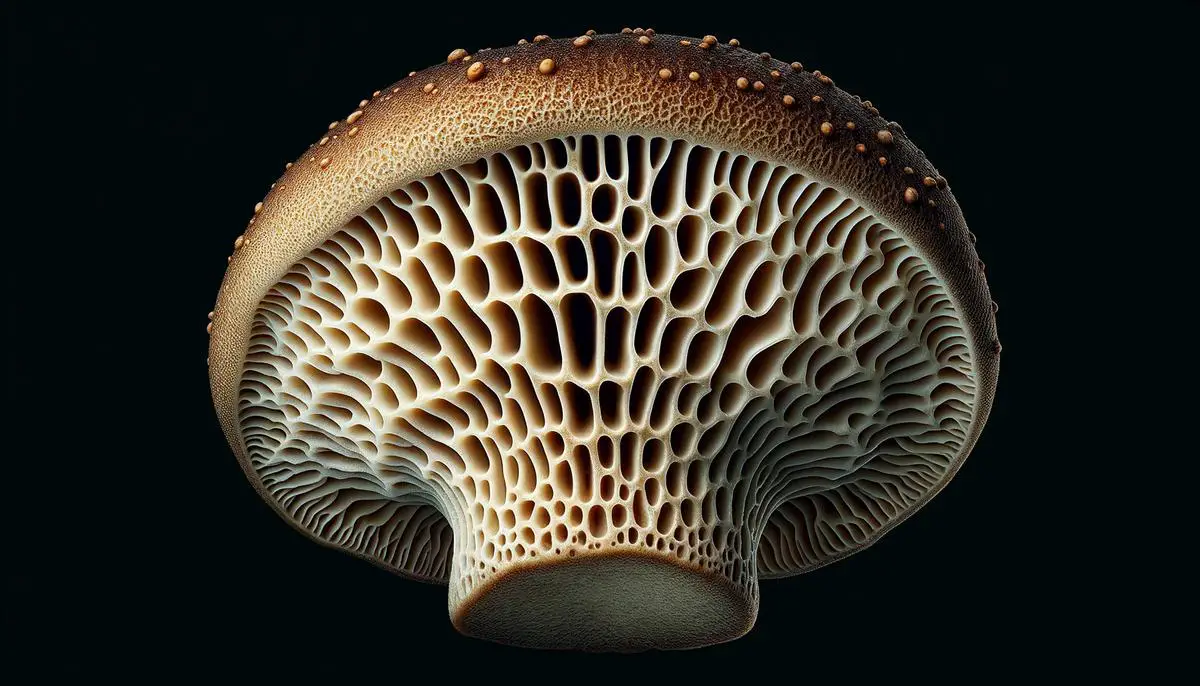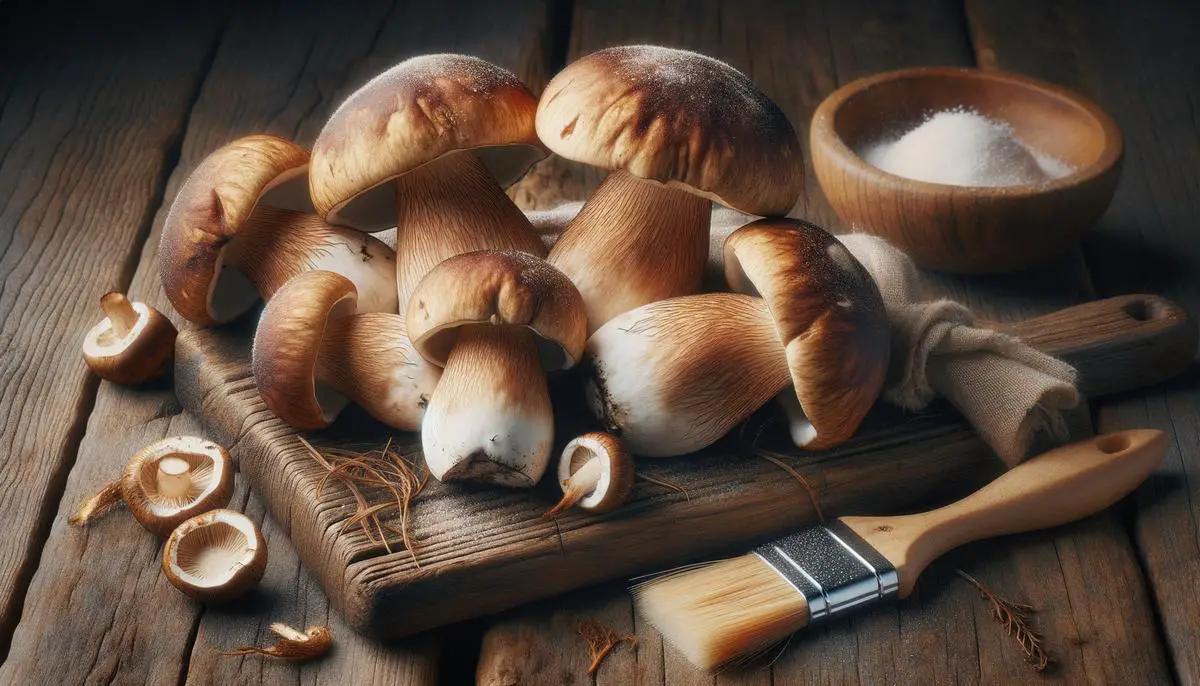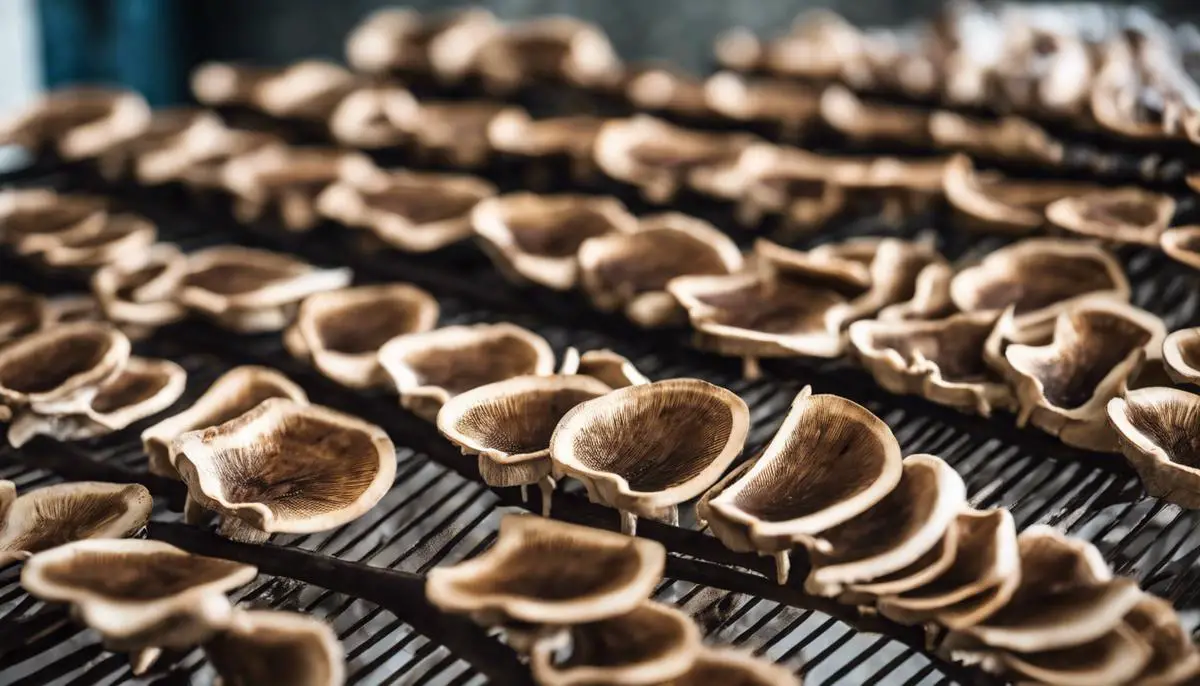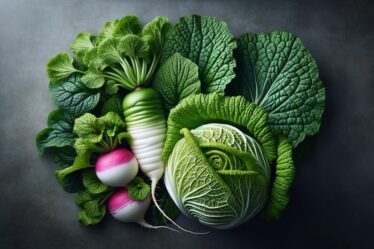
Identification & Varieties
Porcini mushrooms are known for their distinct brown or reddish-brown caps, which are semi-circular and can span up to a foot across. These caps often catch the eye with their size and the white, stubby stalks that support them. The stalks of porcini mushrooms thicken towards the base, creating a robust appearance. The base of the stalk is significantly wider than where it connects to the cap, giving it a unique look.
Under the cap, there is a spongy layer consisting of tiny pores instead of the gills typically found on other mushroom types. These pores change color as the mushroom ages, shifting from white or creamy in young mushrooms to greenish-yellow in older specimens. This feature can help differentiate between porcini mushrooms and their lookalikes.
Porcini mushrooms differ slightly depending on where they grow. In Europe, they are known for their hefty size and dark-colored caps, reflecting the rich, damp forests they emerge from. Their counterparts found in North America, while still large, tend to have slightly lighter caps and favor the coniferous forests spread across the continent.
Porcini mushrooms that grow wild across Italy, France, and parts of North America typically offer a meaty and nutty flavor that's sought after by chefs and food enthusiasts alike. However, it's important to note that subtle differences in appearance and taste can occur due to the mushroom's specific growing conditions and the tree species it partners with for nutrients.
These mushrooms also vary in look and taste depending on their maturity stage. Young porcini mushrooms have caps that are round and fully closed around the stem. As the mushroom matures, the cap opens up, flattening out and exposing more of the spongy layer underneath.
When foraging or choosing porcini mushrooms, observing these detailed characteristics can greatly aid in identifying the true porcinis from their counterparts. Porcinis are celebrated not just for their rich flavor but also for their texture, which can be influenced by their specific variety and growing conditions. By paying close attention to these details, one can ensure that they are enjoying the true essence of this revered mushroom variety.

Culinary Uses
Porcini mushrooms, with their rich and nutty flavors, hold a special place in gourmet cuisine. Their versatility allows them to enhance a wide range of dishes, making them highly esteemed in both traditional and contemporary cooking.
In Italian cuisine, porcini elevate simple ingredients to something sublime. A classic risotto ai funghi becomes a dish fit for royalty when infused with the deep, earthy flavor of porcinis. Likewise, a basic pasta is transformed when adorned with these mushrooms, garlic, white wine, and fresh parsley. The quintessential porcini soup, where their flavor intensifies, accented with a touch of cream and seasoned to perfection, illustrates the mushroom's ability to stand out even in the simplest preparations.
When handling fresh porcini, care must be taken to preserve their texture and aroma. Brushing them gently with a soft brush or cloth is essential to remove any forest remnants. A quick, delicate rinse can be employed only if necessary, promptly patting them dry afterward. The goal is to keep them as untouched by water as possible, as their spongy nature makes them prone to becoming waterlogged, which could mute their flavors.
For dried porcini, patience and care in rehydration will pay off when it comes to flavor. Soaking them in warm water for about 20 minutes not only brings the mushrooms back to life but also leaves behind a flavorful broth that should not be wasted. This aromatic liquid can be used as a base for stocks, soups, and sauces, infusing dishes with a depth of flavor that's unmistakably porcini.
Porcinis also make excellent mushroom pâtés or duxelles, a finely chopped mushroom mixture that serves as a base for stuffings or as a spread. The meatiness of fresh porcini provides a satisfying texture, while the concentrated earthiness of the dried form adds unrivaled taste.
Porcini mushrooms find a special place in the art of preservation, with porcini oil and pickled porcini offering unique ways to enjoy their flavor year-round. A drizzle of porcini-infused oil can elevate a simple grilled meat or vegetable dish, while pickled porcini bring an intriguing twist to antipasti platters and salad garnishes.
There are many opportunities for experimentation with porcini mushrooms. They can be incorporated into a creamy polenta, lending rustic dishes an element of dignified flavor, or married with the subtleness of seafood, crafting a medley where each bite tells a story.
The realm of possibilities with porcini mushrooms is vast. Their capacity to enrich and complement a spectrum of ingredients makes porcini an indispensable classic in the culinary world, ready to enchant palates with each innovative or time-honored preparation they grace.

Harvesting & Availability
Porcini mushrooms primarily make their appearance during the autumn months, though in some regions, they may also be found in the spring. This seasonal nature underscores the fleeting availability of porcinis, making them all the more desired. Found in the damp, rich soils of wooded areas, they grow in partnership with deciduous and coniferous trees, from the forests of Europe to the varied landscapes of North America and parts of Asia.
Porcinis resist the domestication efforts that other mushrooms might submit to. Their dependence on a unique symbiosis with certain trees makes their cultivation a challenge. This wildness compels foragers and mushroom hunters to seek them out, adhering to the secretive whispers of the forests for spots where these treasures hide. As a result, wild porcinis bear the allure of a treasure hunt, emerging from the soil as nature dictates.
The market pulse of porcini mushrooms beats to the rhythm of their natural seasonality and the complexity of their harvest. Prices fluctuate with the scarcity or abundance of each gathering season, making fresh porcinis a luxury to be savored in their fleeting presence. When autumn rains soften the earth and coax the porcinis into the open, markets briefly bask in their glory—only to wait again for the next season's bounty.
On occasion, when conditions favor abundance, dried porcinis offer a year-long solace to those pining for their deep, earthy embrace. This preservation method not only ensures wider availability beyond their ephemeral fresh form but also concentrates their flavor, offering a different yet equally enjoyable culinary experience.
Porcini mushrooms carry with them tales of seasons past, present, and awaited. Their limited availability enhances their gastronomic appeal and imbues them with the mystique of a forest's whisper, a secret revealed only to those who listen. As culinary treasures dictated by the whims of nature, they remind us of the beauty found in the ephemeral and the seasonal rhythms that govern the natural world.

Health Benefits
In the world of nutrition, porcini mushrooms stand out as a potent source of health benefits. Like hidden gems in the dense forests, they bring to the table not only a burst of rich flavor but also a repertoire of wellness attributes that deserve attention.
Rich in dietary fibers, porcini mushrooms aid in promoting a feeling of fullness, supporting weight management efforts and maintaining a healthy gut microbiome—a cornerstone of overall health.
Porcini mushrooms are also a significant source of protein, making them an excellent plant-based alternative for those looking to diversify their protein sources. This is particularly appealing for vegetarians and vegans who seek out flavorful and nutritious substitutes for meat.
Porcinis showcase an array of vitamins and minerals. They are rich in B-vitamins, especially niacin (B3) and riboflavin (B2), which play crucial roles in energy production and maintaining healthy skin and eyes. Their repertoire also includes potassium, a mineral known for its ability to maintain healthy blood pressure, contributing to cardiovascular health. Iron also makes an appearance, offering its services in preventing anemia and maintaining healthy energy levels.
In the contemporary narrative surrounding health and wellness, antioxidants have gained significant attention, and porcini mushrooms eagerly join this elite group. They contain potent antioxidants like ascorbic acid, carotenoids, and tocopherols, which combat oxidative stress and reduce inflammation—a root cause of many chronic diseases.1-3
Despite their impressive health profile, porcini mushrooms have been subject to misconceptions, particularly regarding their potential allergenic properties and mistakenly being associated with toxicity—a fate shared by many wild mushrooms. However, when properly identified, cleaned, and prepared, porcini mushrooms sidestep these concerns, offering a healthful addition to meals.
Culinary enthusiasts and health-conscious individuals alike can rejoice in the symphony of flavors and health benefits offered by porcini mushrooms. By incorporating them into a balanced diet, one can enjoy the numerous health advantages these earthy treasures provide. In the vast world of nutrition, porcini mushrooms stand out as a testament to nature's ability to combine flavor with function, presenting a delicious avenue to health that is as enriching as it is delightful.
Storage & Preservation
Given the fleeting nature of fresh porcini mushrooms, proper storage and preservation techniques become essential to extend their presence in our kitchens. While magic may be scarce, the art of preservation allows these culinary jewels to grace our tables long beyond their initial appearance.
Fresh porcini mushrooms have a tendency to absorb moisture, so careful handling is crucial. Instead of washing them under running water, gently brush or dab them with a damp cloth to remove any traces of dirt or debris.
Once cleaned, wrap the fresh porcini mushrooms in paper towels and place them in a paper bag. Store them in the refrigerator, where they can stay fresh for a few days.
For those looking to enjoy porcini mushrooms throughout the year, drying and freezing are valuable preservation methods.
Drying involves carefully applying warmth and air to the sliced mushrooms, removing moisture while intensifying their flavor. Slice the porcini mushrooms to a uniform thickness and spread them on drying racks, ensuring they don't overlap. A low and slow process in an oven or dehydrator draws out the moisture, leaving behind a concentrated version of the mushroom that can be reconstituted in liquid when needed.
Freezing requires a quick blanching process—a brief immersion in boiling water followed by an ice-cold bath—to halt any enzymatic processes that could dull their flavor. Once patted dry and placed in airtight containers or sealed bags, these porcini mushrooms can be stored in the freezer, ready to be used in winter stews or risottos that crave a touch of autumnal warmth.
The meticulous act of preservation, whether through drying or freezing, pays homage to the transient beauty of porcini mushrooms, ensuring that their journey from forest floor to kitchen enables a longer and more varied culinary experience. It's a testament to the magic housed within their delicate flesh, guaranteeing that their enchanting flavors can be enjoyed across countless meals and memories.

- Kozarski M, Klaus A, Jakovljevic D, et al. Antioxidants of edible mushrooms. Molecules. 2015;20(10):19489-19525.
- Kała K, Krakowska A, Sułkowska-Ziaja K, Szewczyk A, Reczyński W, Opoka W. Kinetics of extracted bioactive components from mushrooms in artificial digestive juices. Int J Food Prop. 2017;20(8):1796-1817.
- Özyürek M, Bener M, Güçlü K, Apak R. Antioxidant/antiradical properties of microwave-assisted extracts of three wild edible mushrooms. Food Chem. 2014;157:323-331.



